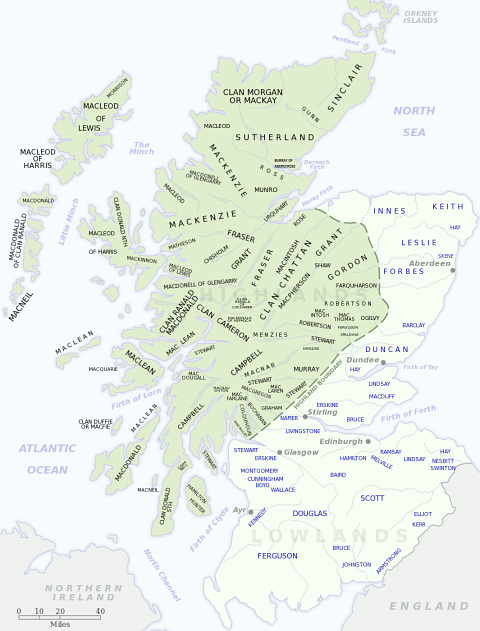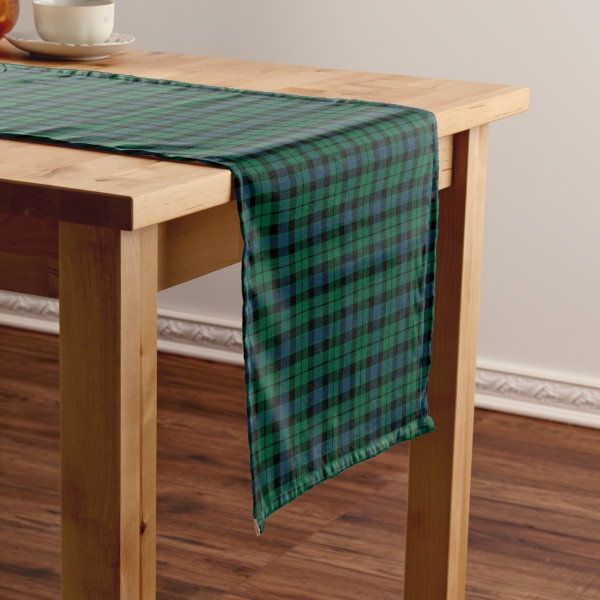
Motto: Manu forti (With a strong hand)
Historic Seat: Castle Varrich
District: Sutherland
Associated Surnames: Bain, MacCay, MacCrie, MacGhee, MacGhie, MacKee, MacQuey, MacQuoid, MacVail, Morgan, Pollard, Polson, Scobie, Williamson
Associated Tartans:
Early MacKay Genealogy and History:
(Excerpt from "The Scottish Clans and Their Tartans", James Grant, 1906)
The Siol Mhorgain, or Clan Morgan, was the ancient patrynomic of the MacKays, the descendants of a pure Celtic stock, who retired into the interior mountain fastnesses before the Norse invaders. Several of this ancient race were called Y, or I (Hugh) MacKay, and were designated of Strathnaver. In Robertson's "Index to the missing Charters of Robert III" there is one to "Gilchreist Macymor M'Cay, of the lands of Kintyre," in the shire of Bute.
In 1427 Angus Dhu MacKay led 4000 men in the feud between the Keith and the people of Caithness. The two armies met at a place called Blair Tannie, and the latter were defeated by the valour of Angus in 1438. In the end of 1442 Angus was burned to death in the church of Tarbet by the men of Ross, whom he had frequently harried. His son, John MacKay of Farre, invaded them in revenge, but was defeated and slain in 1479.
The MacKays had no charters for their lands before 1499, when Iye Roy MacKay of Farre obtained one from James IV. He died in 1512, and was succeeded by his son Donald of Farre and Strathnaver, by charter 1539. In pursuance of a feud with the Sutherlands, he marched to the village of Knockartall, burned it, and afterwards fought his enemies at a place called Aldine-beh, where he was routed, but not before he had slain, with his own sword, William Sutherland, for which, by command of the Queen Regent, he was imprisoned in the Castle of Foulis. In 1556 Mary of Guise went north as far as Inverness, and made the chief of each clan answerable for its good conduct.
"The Laird of Grant," says Balfour, "bringes in the heades of some of his kindred, quhome he could not bring in alive, and presents them to justice. She fynnes the Earl of Cathness ... and sendes the Earl of Sutherland with an armey against MacKay of Strathnauerne by land, and Ihone Kennedy, with a navey by sea, qho brought him prisoner to Edinbrughe Castle, quher he lay for a long tyme thereafter."
In 1626 Sir Donald MacKay of Strathnaver levied a regiment of 2000 men for service in Bohemia and Sweden.
He was made a Baronet of Nova Scotia in 1627, and in 1628 a Peer of Scotland by the title of Lord Reay. He jonied Charles I, and was taken prisoner when Newcastle was stormed by the Scottish army and sent to the Tolbooth of Edinburgh, after which he went to Sweden, where he was made Governor of Bergen in 1649, and died soon after. In the year named, the Abrach MacKays invaded Caithness, and a bloody conflict ensued near Thurso. Lord Reay's country now belongs to another race and name, and, until recently, the family for more than one generation resided in Holland, but have returned permanently to Scotland. The MacKays of Scourie, and Auchness, are considered the next oldest branch.
Hugh MacKay of Scourie, from being an ensign in the Scots Royals in 1660, in 1674 found himself Major-General at the head of the Scots-Dutch Brigade in succession to Claverhouse, by whom he was defeated at Killicrankie.1 His long career of service was a most brilliant one, and the soldiers were wont to say that "Hugh feared nought but God!" He fell at the battle of Steinkirke2 in 1692. He left a descendant, Baron Æneas MacKay, Chamberlain of Holland, who became heir to the Peerage of Reay.
John MacKay of this clan, the eminent botanist, was the founder of the Botanical Garden at Edinburgh, where he died in April 1802.
When the last Sutherland Fencibles, a corps disbanded in 1798, was embodied in 1793, there were many MacKays in its ranks - over 104 being William MacKays, of whom there were seventeen in the company of Captain Sackville Sutherland.
Baron Æneas MacKay, tenth Lord Reay, died in 1876 and was succeeded by his son, Donald, eleventh and present Lord Reay (born 1839).
(End excerpt)
Next page: Clan Mackenzie
1 The Battle of Killiecrankie (1689): The Battle of Killiecrankie was fought on 27 July 1689 near Killiecrankie, in Perthshire, Scotland. It took place during the First Jacobite Rising between a Jacobite force of Scots and Irish, and those of the newly arrived William of Orange's Scottish government forces. Read more about the Battle of Killiecrankie at Wikipedia.
2 The Battle of Steenkerque: Fought on 3 August 1692 in present-day Belgium as a part of the Nine Years' War (1688–1697), a conflict between Louis XIV of France and a European coalition of the Holy Roman Empire (led by Austria), the Dutch Republic, Spain, England, and Savoy. It was fought in Europe and the surrounding seas, in North America and in India. It is sometimes considered the first global war. Read more about the Battle of Steenkerque at Wikipedia.

Distribution of Scottish clans and families
View larger map at Wikimedia Commons

Browse the Clan MacKay Tartan Collection with home decor, personal accessories, crafting, paper products, and more.

Clan MacKay Postcard: Digitally cleaned and enhanced vintage illustration with tartan border.